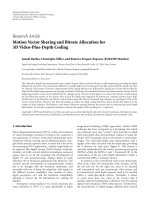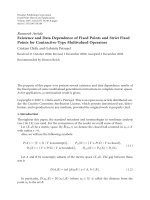Research Data Sharing and Data Availability
Bạn đang xem bản rút gọn của tài liệu. Xem và tải ngay bản đầy đủ của tài liệu tại đây (340.31 KB, 2 trang )
Research Data Sharing and Data Availability Statement
What is Data Availability Statement?
It is a statement describing the research data, how and where it can be accessed, and under what
conditions. It may contain links to data sets or guidance on how to find the raw data.
What is Research Data?
Research data is the raw data of the study supporting its findings. It can be in many forms such
as spreadsheets, videos, presentations, software codes, questionnaires, and other formats. In
the past few years, many journals started to encourage authors to share their research data and
include data availability statements in their submitted manuscripts.
Why Sharing Research Data is Important?
• It creates a comprehensive and transparent publication that allows readers to understand
and validate the findings.
• It promotes new collaboration opportunities with other co-authors who may be interested
in a similar research area.
• It increases your number of citations, as you get proper attribution and citation of your data
when it is cited in a repository that gives a DOI.
• It enhances the reproducibility of your research.
• It advances a wider application of your research.
• It encourages other researchers to reach new findings.
How to Share Your Research Data
There are three ways to share your research data:
1. Data Repositories
It is the first and the most preferred way to share your research data as they are more accessible,
discoverable, and searchable than the other data sharing ways. A good repository should:
•
•
•
•
•
be accessible with no restrictions,
have a clear license and terms,
provide Digital Object Identifiers (DOIs),
be familiar to the research community,
and offer long-term data preservation.
You can find a suitable repository by exploring the Repository Finder or FAIRsharing.
2. Supplementary Files
The second way is to share your research data by submitting the raw data along with your submission as supplementary files. It does not have the same value as public repositories.
3. Data Available upon Request
The third way is to clearly indicate contact details of a person or a committee who should be
contacted to access the research data. This usually happens when the author used third-party
data or they do not own the data.
If your research data is restricted due to legal, ethical, or any other concerns, you should add a clear
explanation of why the data access is restricted.
Sharing your data requires a proper citation in the text and in the reference list. Hosting your data in
a repository that provides a Digital Object Identifier (DOI) facilitates the citation of data sets.
How to Write a Data Availability Statement
To write a data availability statement, you will need to answer the following questions:
• What is the raw data supporting the findings of your research?
• Where can the research data be found and accessed?
• What are the conditions and guidance to access these data?
• Why cannot the research data be accessed (If it is restricted)?
It is likely placed at the end of the research before the Acknowledgement section. Here you are
some templates selected from publishers’ guidelines:
The data supporting the findings of this study are openly available in [repository name] at
reference number [reference number].
The data supporting the findings of this study are available within the article.
The data supporting the findings of this study are available within the supplementary
materials.
The data supporting the findings of this study are available on request from the corresponding author.
The data are not publicly available due to [explain restrictions].
Data sharing is not applicable to this article as no new data were created or analyzed in this
study.
Okay, now we have covered all aspects around research data sharing and data availability statements.
Let’s get in touch to discuss your thoughts.
Resources and Further Readings:
/> /> /> /> /> />









